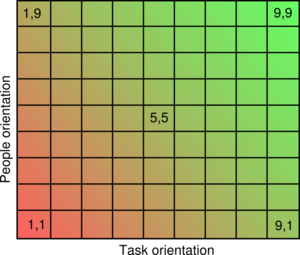Blake and Mouton managerial grid
| Blake and Mouton managerial grid |
|---|
| See also |
Robert Blake and Jane Mouton built two-dimensional grid of common leadership styles, in which on-axis scaled from 1 to 9 described two factors: the orientation of production and orientation of people. On this basis, they have identified five common styles (fig. 1).
Main styles of managerial grid
1.1: Low focus on results and on people
Blake and Mouton called this style Impoverished Management because managers in such style, exert minimum effort to get work done. In particular it is characterized by:
- no requirement or minimum requirements,
- avoidance of conflicts,
- unwillingness to change and innovation,
- lack of motivation to improve performance and self-improvement.
9.1: Very high focus on results, little focus on people
This style is called Authority-Obedience because managers use strict means to control people and attain perfect obedience. Managers try to arrange work conditions to minimize influence of social and psychological factors in work place. In particular it is characterized by:
- high expectations, finding the most efficient workers,
- in the event of a conflict, manager try to subjugate the people,
- innovation comes only from the manager,
- employees are motivated solely by economic incentives and coercion.
1.9: Very high focus on people, carefree and friendly atmosphere
Style called Country Club Management by Blake and Mouton. Managers pay very high attention to relationships within organization, try to make work comfortable for people and maintain friendly atmosphere with minimal daily stress. In particular it is characterized by:
- selecting for employees capable of teamwork,
- avoidance of conflict, in the case of an attempt to extinguish the conflict,
- small innovation, due to lack of pressure (task, time, financial),
- high personal motivation, self-fulfilment opportunities.
5.5: Adequate performance at work, a compromise between the results and the rights of co-workers
So called Organization Man Management is the most common (average) style in many organization. Managers attain adequate organization performance through balanced activities toward people and tasks. In particular it is characterized by:
- requirements established by regulations (norms, procedures, etc.),
- most conflicts are caused by breaking rules and principles, and manager quickly deals with them,
- there are some innovations in the production (but not breakthrough),
- motivation is a compromise between the goals of individuals and organizations, tangible and intangible incentives.
9.9: High performance at work, satisfied employees
Blake and Mouton called this style Team Management, but it is also called Effective style due to its role in maintaining high commitment in organization. Use of this style leads to good relationships, trust and respect within team, and at the same time high eagerness to achieve ambitious company objectives. In particular it is characterized by:
- managers look for highly qualified specialists with high ethical competences,
- conflicts are resolved quickly and rationally through direct confrontation with the problem,
- very high level of willingness to innovate of employees and managers,
- high motivation of group, attained through sustainable use of tangible and intangible incentives.
See also:
- Management styles
- Reddin's basic management styles
- Lewin, Lippitt and White - basic styles of management
References
- Blake, R. R., Mouton, J. S., & Bidwell, A. C. (1962). Managerial grid. Advanced Management-Office Executive.
- Blake, R. R., & Mouton, J. S. (1964). The new managerial grid: strategic new insights into a proven system for increasing organization productivity and individual effectiveness, plus a revealing examination of how your managerial style can affect your mental and physical health. Gulf Pub. Co..
- Blake, R. R., & Mouton, J. S. (1985). The managerial grid III: The key to leadership excellence.
- Blake, R. R., & McCanse, A. A. (1991). Leadership dilemmas--grid solutions. Gulf Professional Publishing.
